Written by Christine Amour-Levar, Co-founder Investors for Climate
In the intricate tapestry of our world's challenges and opportunities, there exists a thread that weaves through disparate realms - touching upon everything from the environment to corporate governance and the rapidly evolving world of technology. It is a thread of profound importance, yet one that is often overlooked or underestimated: gender.
As someone deeply committed to fostering positive change in society, I have witnessed first-hand how gender plays a pivotal role in shaping our response to the pressing issues of our time. Whether it be the unequal burden of climate change on women, the transformative power of gender diversity in corporate leadership, or the critical need for women's voices in shaping our technological future, the presence—or absence—of gender considerations can make all the difference.
Gender, Climate Change, and Environmental Sustainability
A few months ago, I had the incredible privilege of embarking on an expedition to Antarctica, joining a team of dedicated scientists from the Earth Observatory of Singapore. Our primary objective centred on conducting cutting-edge research focused on the Antarctic ice sheet to gain deeper insights into the far-reaching consequences of its melting, particularly for regions with low-lying coastlines, such as Southeast Asia.
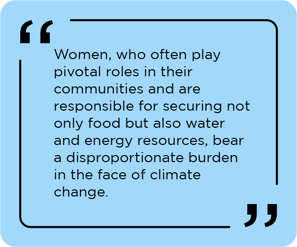 Witnessing first-hand, the alarming rate at which the ice is melting had a profound and humbling impact on me. It sharpened my awareness of the existential threat posed by rising sea levels, with a particular emphasis on the vulnerabilities faced by women. Women, who often play pivotal roles in their communities and are responsible for securing not only food but also water and energy resources, bear a disproportionate burden in the face of climate change.
Witnessing first-hand, the alarming rate at which the ice is melting had a profound and humbling impact on me. It sharpened my awareness of the existential threat posed by rising sea levels, with a particular emphasis on the vulnerabilities faced by women. Women, who often play pivotal roles in their communities and are responsible for securing not only food but also water and energy resources, bear a disproportionate burden in the face of climate change.
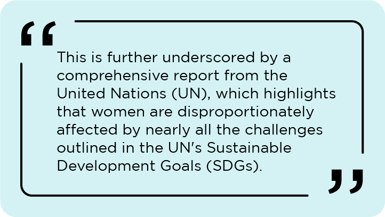 In fact, more than two-thirds of studies show that women face greater health risks due to climate change. The world's most vulnerable regions, where women often take on these critical responsibilities, are hit hardest. This is further underscored by a comprehensive report from the United Nations (UN), which highlights that women are disproportionately affected by nearly all the challenges outlined in the UN's Sustainable Development Goals (SDGs).
In fact, more than two-thirds of studies show that women face greater health risks due to climate change. The world's most vulnerable regions, where women often take on these critical responsibilities, are hit hardest. This is further underscored by a comprehensive report from the United Nations (UN), which highlights that women are disproportionately affected by nearly all the challenges outlined in the UN's Sustainable Development Goals (SDGs).
For instance, natural disasters, which have become increasingly prevalent due to the climate crisis, often have a disproportionate impact on women, children, the impoverished, the elderly, and the disabled, whose voices and perspectives frequently go unheard or unheeded.
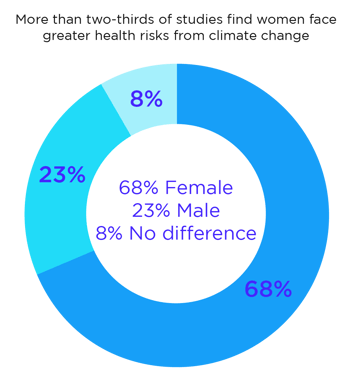
Pie chart displaying the findings of 130 studies on climate change and health: 89 studies found women were more affected than men, 30 found men were more affected than women and 11 found no difference in how men and women were affected. Rounding errors mean the proportions may not add up to exactly 100%.
Data source: Global Gender and Climate Alliance (2016). Additional analysis by Carbon Brief.
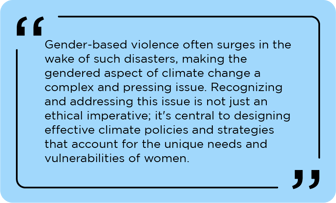 As I’ve witness on multiple occasions via my work in the field with my NGO, HER Planet Earth, when climate change intensifies resource scarcity, women find themselves on the frontline of these challenges. Beyond resource management, women's limited access to decision-making processes leaves them more vulnerable to climate-induced disasters. Gender-based violence often surges in the wake of such disasters, making the gendered aspect of climate change a complex and pressing issue. Recognizing and addressing this issue is not just an ethical imperative; it's central to designing effective climate policies and strategies that account for the unique needs and vulnerabilities of women.
As I’ve witness on multiple occasions via my work in the field with my NGO, HER Planet Earth, when climate change intensifies resource scarcity, women find themselves on the frontline of these challenges. Beyond resource management, women's limited access to decision-making processes leaves them more vulnerable to climate-induced disasters. Gender-based violence often surges in the wake of such disasters, making the gendered aspect of climate change a complex and pressing issue. Recognizing and addressing this issue is not just an ethical imperative; it's central to designing effective climate policies and strategies that account for the unique needs and vulnerabilities of women.
Josephine Ekiru Photo credit: USIP
Several years ago, during a trek through Northern Kenya's Karisia Hills, I had the privilege of meeting an incredible woman named Josephine Ekiru, hailing from the Turkana community. Josephine's remarkable life story, which began as a young girl in a modest Kenyan village, took an astonishing turn when she narrowly escaped an encounter with armed poachers. This life-changing experience led her on a path of unwavering dedication, transforming her into a passionate steward of the environment and a revered leader within her community. Determined to safeguard her culture and environment, she initiated community meetings to raise awareness and implement vital water conservation measures. Recognizing the value of education, she introduced environmental programs in local schools to empower the younger generation. Additionally, she collaborated with NGOs and governmental agencies, advocating for sustainable land management policies, and ensuring her community's voice reached regional and national platforms. Josephine's journey serves as a poignant testament to the power of determination and resilience. Her story also underscores the pivotal role that women can assume in addressing the pressing climate crisis that confronts their communities.
Gender Diversity in Board Governance
A few years ago, I wrote a piece in Forbes about Diversity on Singapore Boards, at the time the Island Nation was targeting to have 20% female representation on boards by 2020. As of June 2023, Singapore hit 22.7% of women on boards of listed companies, but this is still behind comparative figures in first world countries such as Norway, where it is 43.1%.
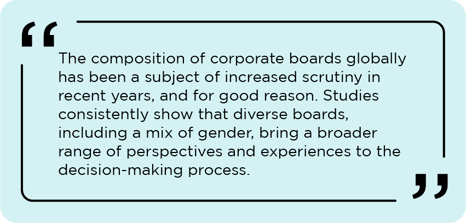
The composition of corporate boards globally has been a subject of increased scrutiny in recent years, and for good reason. Studies consistently show that diverse boards, including a mix of gender, bring a broader range of perspectives and experiences to the decision-making process. This diversity leads to better decision-making, enhanced corporate performance, improved governance and less greenwashing overall.
The connection between women serving on corporate boards and increased profitability has also been reaffirmed by the Women Count 2022 study, conducted on FTSE350 companies by the diversity consultancy, The Pipeline. The study revealed that companies with over a quarter of women on their executive committees reported a remarkable profit margin of 16%, which is more than ten times higher than those without any female board members.
profitability has also been reaffirmed by the Women Count 2022 study, conducted on FTSE350 companies by the diversity consultancy, The Pipeline. The study revealed that companies with over a quarter of women on their executive committees reported a remarkable profit margin of 16%, which is more than ten times higher than those without any female board members.
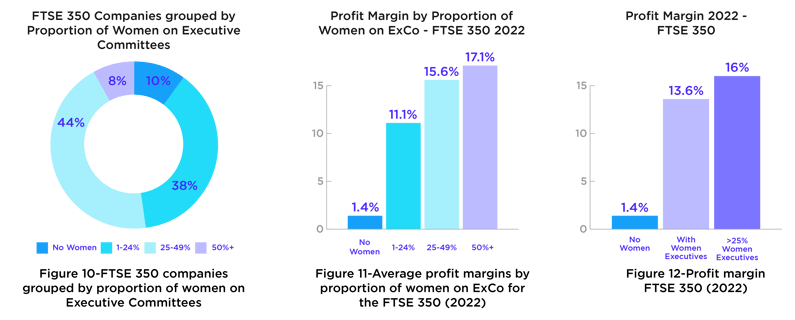
Efforts to increase gender diversity on boards have not only broken-down gender barriers in the corporate world but have also challenged traditional roles and expectations. By ensuring that women have a seat at the boardroom table, organizations can benefit from a broader range of skills and ideas, fostering innovation and resilience in the face of challenges like climate change.
Gender Bias in Technology Development
Historically, this realm of technology has been dominated by men, resulting in a notable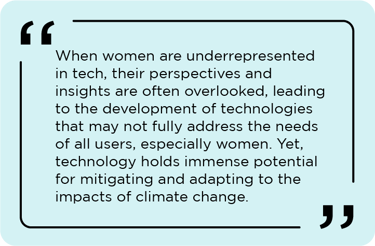 underrepresentation of women in tech roles. This gender imbalance extends to tech-driven solutions for climate change and sustainability. When women are underrepresented in tech, their perspectives and insights are often overlooked, leading to the development of technologies that may not fully address the needs of all users, especially women. Yet, technology holds immense potential for mitigating and adapting to the impacts of climate change. From renewable energy solutions to data-driven climate modelling, technology is at the forefront of our response to the crisis.
underrepresentation of women in tech roles. This gender imbalance extends to tech-driven solutions for climate change and sustainability. When women are underrepresented in tech, their perspectives and insights are often overlooked, leading to the development of technologies that may not fully address the needs of all users, especially women. Yet, technology holds immense potential for mitigating and adapting to the impacts of climate change. From renewable energy solutions to data-driven climate modelling, technology is at the forefront of our response to the crisis.
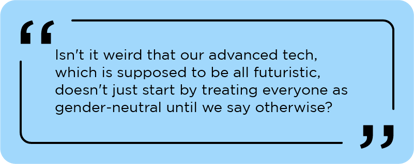 I had a conversation with my 16-year old son, Louis, the other day. He's the founder of his high school's 'Ethical Hacking Society' and has a deep passion for technology and AI. So I asked him his thoughts on gender bias in technology, and he replied, "Isn't it weird that our advanced tech, which is supposed to be all futuristic, doesn't just start by treating everyone as gender-neutral until we say otherwise?"
I had a conversation with my 16-year old son, Louis, the other day. He's the founder of his high school's 'Ethical Hacking Society' and has a deep passion for technology and AI. So I asked him his thoughts on gender bias in technology, and he replied, "Isn't it weird that our advanced tech, which is supposed to be all futuristic, doesn't just start by treating everyone as gender-neutral until we say otherwise?"
Interestingly, recent research from the Tasmanian School of Business and Economics at the University of Tasmania highlights how AI-generated content can perpetuate harmful gender biases. Moreover, UNESCO data reveals that only 12 percent of AI researchers are women. Clearly, there's a pressing need for a conscious, deliberate effort to not only encourage more women to enter the field but also to ensure that the field represents the diversity of our population.

Like all sectors, the AI industry should strive for equality, both in its approach and perspective. There's no denying that AI companies need to attract more women to tech roles, diversifying the talent pipeline and the workforce behind these cutting-edge technologies.
Harnessing Gender for a Sustainable Future
As we stand at the intersection of gender and these critical spheres—climate change, board governance, and technology development—understanding the role of gender is essential for a sustainable future. This isn't just about righting historical wrongs; it's about building a future that is more equitable and works for everyone.
To move forward, we must consider a multifaceted approach:
- Gender-Inclusive Climate Policies
Climate policies should be designed to address the unique needs of women, including access to resources and decision-making power. - Board Diversity
Companies should actively seek gender diversity on their boards, not just as a matter of diversity and inclusion, but to drive innovation and effective governance. - Closing the Tech Gender Gap
The technology sector must prioritize efforts to close the gender gap, encouraging more girls to choose STEM careers, promoting inclusivity, and ensuring that women are represented in tech leadership roles. - Collaboration and Awareness
Collaboration between governments, businesses and civil society organizations is crucial. Raising awareness about the intersections of gender in these realms is the first step towards change.
In truth, it is unquestionable that gender plays a pivotal role in addressing the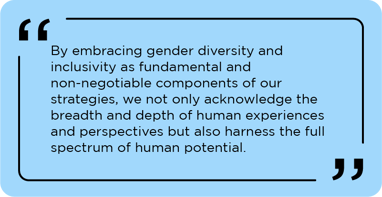 complexities of climate change, board governance, and technology development. By embracing gender diversity and inclusivity as fundamental and non-negotiable components of our strategies, we not only acknowledge the breadth and depth of human experiences and perspectives but also harness the full spectrum of human potential. This inclusive approach doesn't just benefit a select few; it enriches society as a whole and propels us toward a more equitable, resilient, and sustainable world.
complexities of climate change, board governance, and technology development. By embracing gender diversity and inclusivity as fundamental and non-negotiable components of our strategies, we not only acknowledge the breadth and depth of human experiences and perspectives but also harness the full spectrum of human potential. This inclusive approach doesn't just benefit a select few; it enriches society as a whole and propels us toward a more equitable, resilient, and sustainable world.
The urgency of action cannot be overstated. As we venture into this future, we must do so with the understanding that embracing gender as a catalyst for change isn't just a choice; it's an imperative if we are to create a world where everyone has a stake, a voice, and an opportunity to thrive.


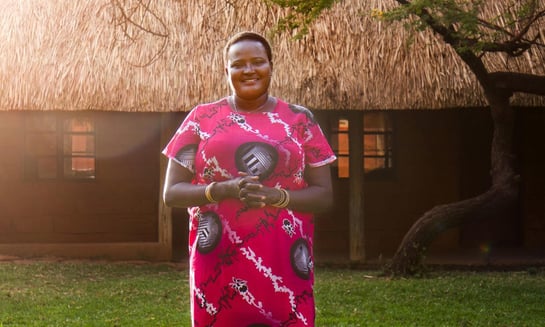
COMMENTS